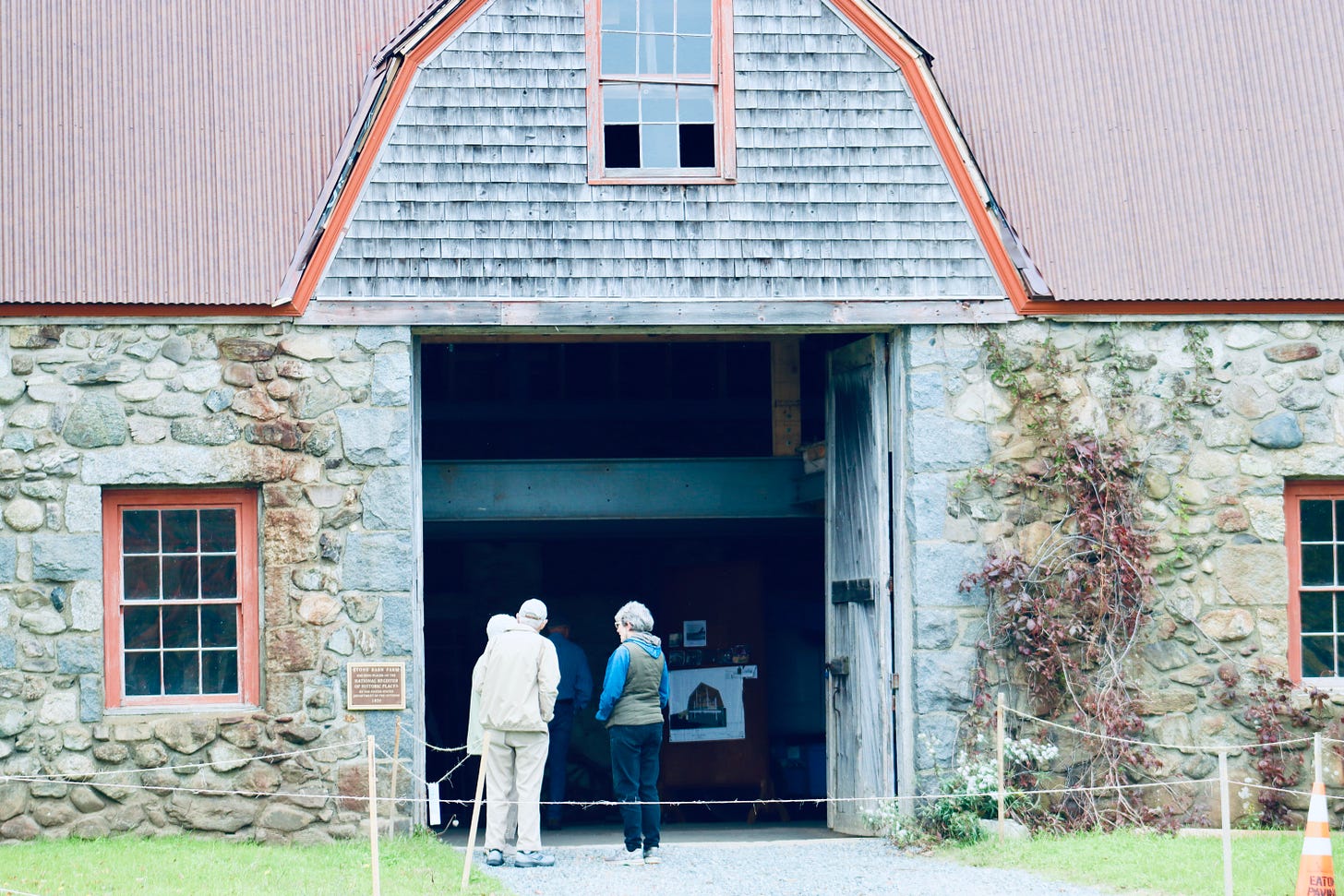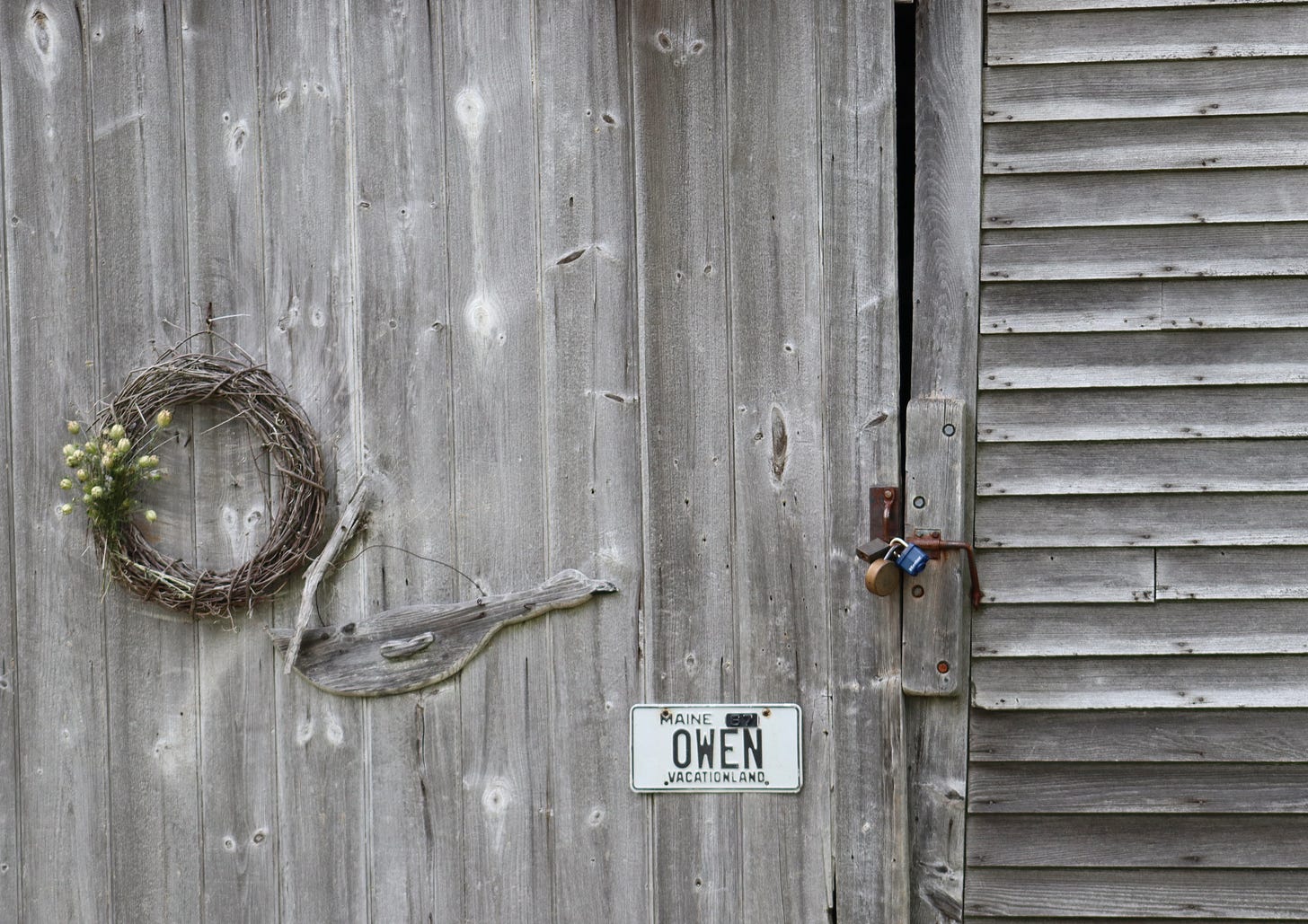Harry Owen, Who Built a Legacy of Story and Conservation, Dies at 97
BAR HARBOR—On New Year’s Day, Mount Desert Island lost Harry Owen, but his legacy and love for the land will live on.
According to his obituary, Harry’s passing was peaceful as he was surrounded by friends at Birch Bay. He was 97.
During those 97 years, Harry became a bit of an icon. Possibly more than a bit for conservationists, for visitors, for artists, for the students he taught, and for storytellers. Artist Bob Jay painted not just the land where Harry lived and the iconic stone barn, but Harry, too.
“Harry was born March 24, 1927, the son of Ralph I. and Frances A. (Bailey) Owen and raised outside Cleveland, Ohio. After attending Kent State University, he enlisted in the United States Navy where he served on submarines in the Pacific during the Korean War. He then taught in the first consolidated school in Fairbanks, Alaska. After moving to Maine in the early 1960s, Harry was a teacher at Bar Harbor High School, then Sumner Memorial High School in Sullivan, where he taught wood shop and other courses until his retirement in 1980,” his obituary reads.
Harry was a teacher and an advocate, vocal against power line transmissions and over development and concerned about deer. His passion for preserving the home, field, and lands around the stone barn has created a lasting legacy. The barn where Harry and his wife Mary “Cindy” lived after they purchased it in 1963 has become a protected part of the island.
As his obituary reads, “Harry often remarked, ‘I felt I was put on Earth to protect this land.’”
The deer, he is once quoted as saying, have every right to be on Mount Desert Island as the humans do.
Harry had lived in a cabin in Fairbanks, Alaska. Cindy travelled the world while a nurse employed by a French diplomat’s family.
In a letter to the editor in the 2006 Mount Desert Islander, Harry wrote that he and Cindy “came to Bar Harbor to escape the maddening crowd.” He worried about focusing on the carrying capacity of the land during planning and likened the island to a lifeboat that was sinking because of the pressures of development.
“Harry loved the Stone Barn Farm and, through his extraordinary generosity, made it available for the enjoyment of his neighbors while he lived there, and now in perpetuity for all to find solace and renewal in nature,” said State Legislator and Bar Harbor Town Council Vice Chair Gary Friedmann. “He was a caring, thoughtful, and good humored man who knew the value in giving more than he received.”
As a shop teacher, he gave countless Hancock County students the skills they needed to work with wood, to build things, to restore them, and to save them.
THE STONE BARN LEGACY
“Hey, Harry!”
“Harry!”
“Good afternoon, Harry!”
“Harry!”
“Is that Harry over there? It is! Harry!”
When Harry Owen walked onto the grounds of Bar Harbor’s Stone Barn Farm Preserve at the corner of Crooked Road and Norway Drive for an October 2023 celebration, he was embraced by a chorus of greetings, smiles, and the occasional, enthusiastic hugs, catching up with friends and strangers-who-are-already-his friends as they celebrating the land that he and Cindy Owens took care of for decades. That Saturday was a celebration of the barn’s restoration and preservation.
“Who is that man?” one young girl asked as Harry was surrounded by well-wishers.
“Someone special,” her dad answered.
The little girl nodded like she knew that her dad had to be right.
According to Maine Coast Heritage Trust, “In 2001, the Owens conserved their property through a conservation easement with Maine Coast Heritage Trust (MCHT). It acquired the property in 2019 to open it as a preserve.”
The Owens, Maine Coast Heritage Trust, and community donors worked with architect Carla Haskell, engineer Dennis Riley, and general contractor R.L. White to preserve a barn that dates to the early 1900s, a barn and farm that’s been photographed by professional photographers and visitors. The farm is 128 acres and about 20 of that is open field. There is forest. There is frontage on Northeast Creek. There’s a pond. There are wetlands. And there are memories of the Owens everwhere.
The cedar-shingled farmhouse dates back to between 1840 and 1860. The carriage house from sometime in the late 1800s.
Maine Coast Heritage Trust has been restoring and stabilizing the structures on the property, which includes the barn, the farmhouse, the carriage house and gazebo.
Harry and Cindy were people who served their community. Harry taught. Cindy nursed. Harry gardened in the spring. Their sunflowers, planted where lettuce gardens once where, inspired photos and poems and scarecrow wardrobe changes. They hosted weddings. They cultivated story after story, memory after memory.
They worried about development on the island.
Harry wrote in a MCHT survey ““I feel that development on MDI is a disaster—within the next ten years every available field and wood and lot will be subdivided for houses. The whole character of the Island will be changed—MDI will become suburbia.”
Owen didn’t want house lots, not even 42 of them, which at the time would have been allowable in the town’s land use ordinances. So, they put the land into a conservation easement. That means that it cannot be developed.
Before she died in 2018, Cindy was quoted as saying, “It’s our way of giving back to our friends and our community for all the happy times we’ve had here.”
THE OWENS
In their time on the property, the Owens raised goats, chickens, and horses. They put panoramic windows in the kitchen so that they could gaze onto the pond and the field that rounds up. Cranberries grow on the meadow edges. They’d walk the property the same way so many do now.
They bought the farm for $17,000 and Harry’s quoted in a 2005 Meredith Goad piece in the Portland Press Herald as saying, “We were living in Seal Harbor and I was looking for a farm. My life’s work idea was to teach in the wintertime and farm in the summertime.”
They couldn’t find a place.
But a doctor at the hospital mentioned the Stone Barn Farm to Cindy. She and Harry headed over. They knocked on the door. And it opened.
“We talked them into moving to Florida,” Cindy recalled to the Press Herald, “and we bought the place from them.”
They loved it. They weren’t alone. It became a popular place for strangers to stop. It became a place of photos and dreams, weddings and graduation pictures. Phish fans, having moseyed down to the island after a concert up in The County, stopped by and ended up pitching a tent in the backyard. Vogue Magazine did a photoshoot. Harry had cleaned the house so it was spotless, but the crew only took photos outside.
The Owens would tell people to send their best photos to them. They’d put them on the walls of the house. Even inside the home, you’d see the barn from multiple angles at multiple seasons, all through the lens of the people who stopped, who noticed, who wanted to preserve that moment.
Once, a German woman sent Harry a photo she’d taken of his house. She didn’t know his address. She sent it “to the gentleman who grows beautiful sunflowers near the gray stone barn.”
It got there.
That says something about the Owens. The stories got to them. They helped create them and preserve them. The couple took care of stranger after stranger. And the Owens? They welcomed everyone the same way Harry welcomed people saying hello to him on that Saturday in October. With a smile. With open arms. With an eye toward community.
That’s a legacy that Harry and Cindy have left behind not just for the land and their own family, but for those deer and people that frolic on it as well.
According to his obituary, “Harry is survived by his daughter Carol and Gary Fortier of Ellsworth, Maine; granddaughter Jennifer and Elias Ayrey and great-granddaughter Mia of Bellingham, Washington; his sister Beverly Hegedish of Twinsburg, Ohio, and her extended family; and many wonderful neighbors and friends. He was predeceased by his cherished wife, Cindy, who passed away in 2018.
A celebration of life will be planned to honor both Harry and Cindy in the summer of 2025. There will be stories told there, too, as the Owens’ legacy and love for the island continues on.
To contribute a story of the Owens’ lives or your own memories of the Stone Barn Farm, please visit www.stonebarnfarmstories.com. Jennifer Fortier Ayrey has been gathering them.
Donations may be made in their name to Maine Coast Heritage Trust, P.O. Box 669, Mt. Desert, ME 04660, to further their preservation of the property.
Unless otherwise specified, photos: Shaun Farrar and Carrie Jones
LINKS TO LEARN MORE
Jennifer Fortier Ayrey’s site where she’s gathering stories of the barn.
Portions of this story originally appeared in the piece below:
Learn more about the cultural and natural history of Stone Barn Farm.
https://www.mcht.org/about-us/
For a virtual tour of the barn
If you’d like to donate to help support us, you can, but no pressure! Just click here (about how you can give) or here (a direct link), which is the same as the button below. Our mailing address is 98 Ledgelawn Ave., Bar Harbor, Maine, 04609
If you’d like to sponsor the Bar Harbor Story, you can! Learn more here.

















